树
二叉树
二叉树具有唯一根节点
二叉树每个节点最多有两个孩子,最多有一个父亲
二叉树具有天然递归结构
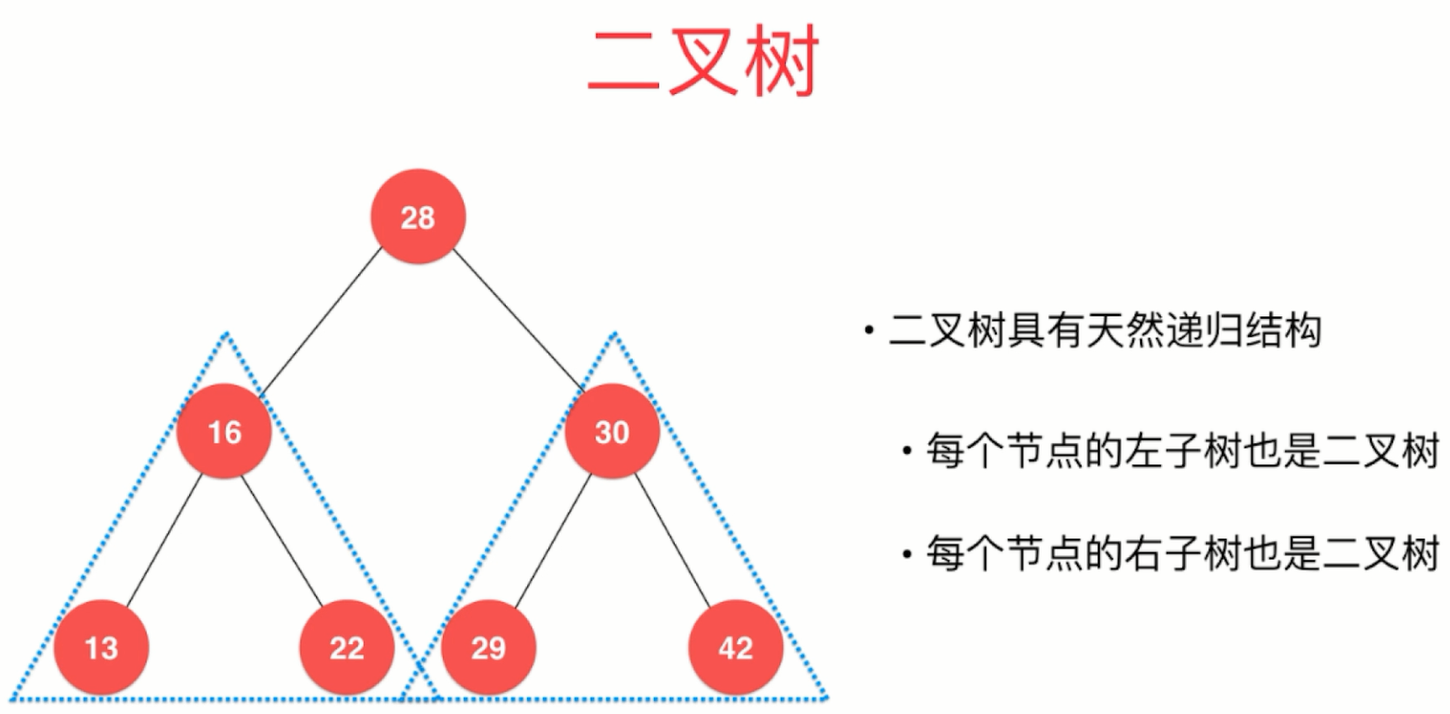
二叉树不一定是 “满” 的:一个节点也是二叉树、空节点也是二叉树
二叉搜索树(BST)
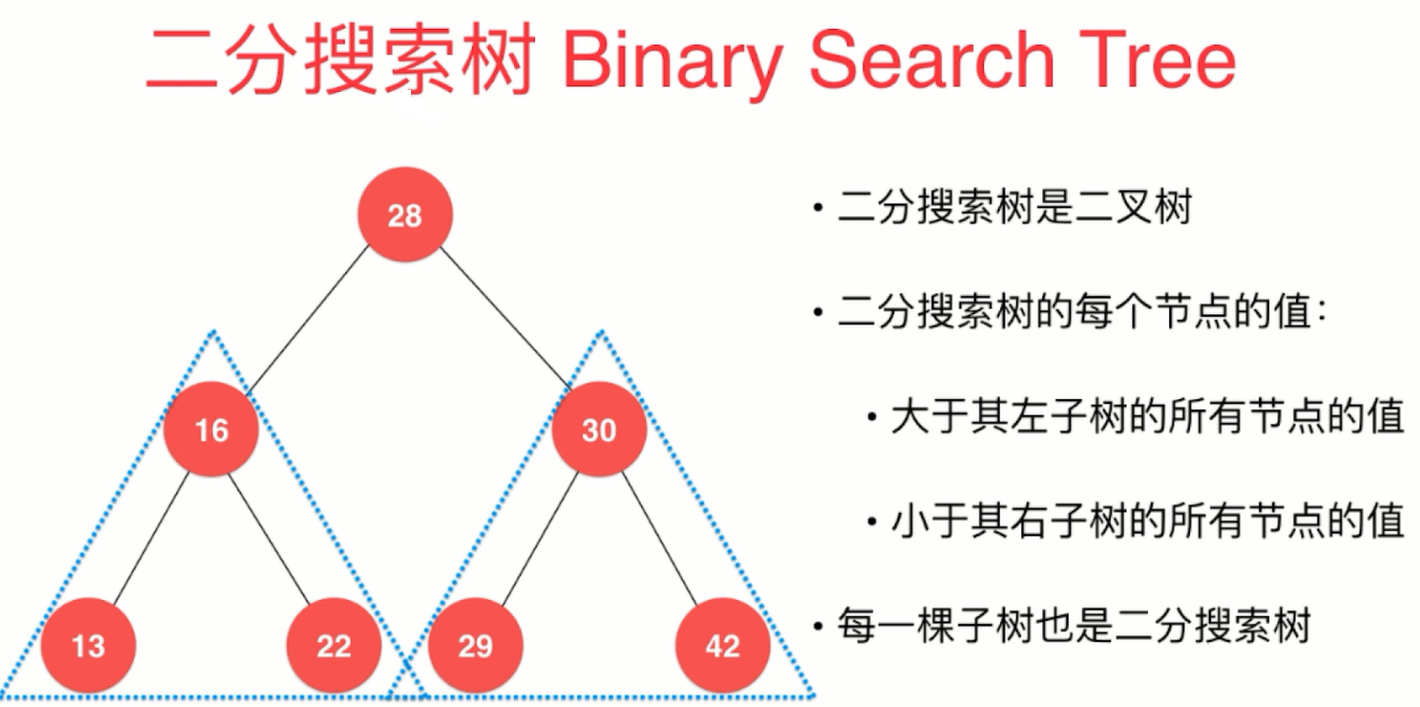
BST 的基本功能
public class BST> {
private Node root;
private int size;
public BST(){
root=null;
size=0;
}
public int size(){
return size;
}
public boolean isEmpty(){
return size==0;
}
private class Node{
public E e;
public Node left,right;
public Node(E e){
this.e=e;
this.left=null;
this.right=null;
}
}
}
添加元素
思路
对于如下的 BST,向其中添加 28:
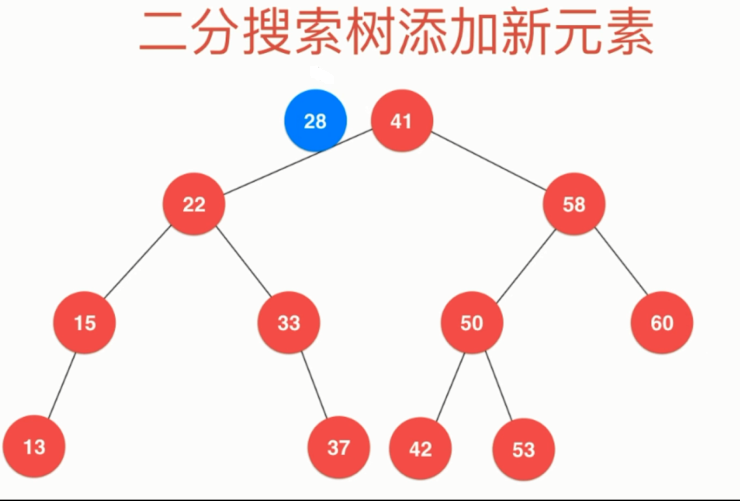
28 与根结点 41 比较,应该插入左子树
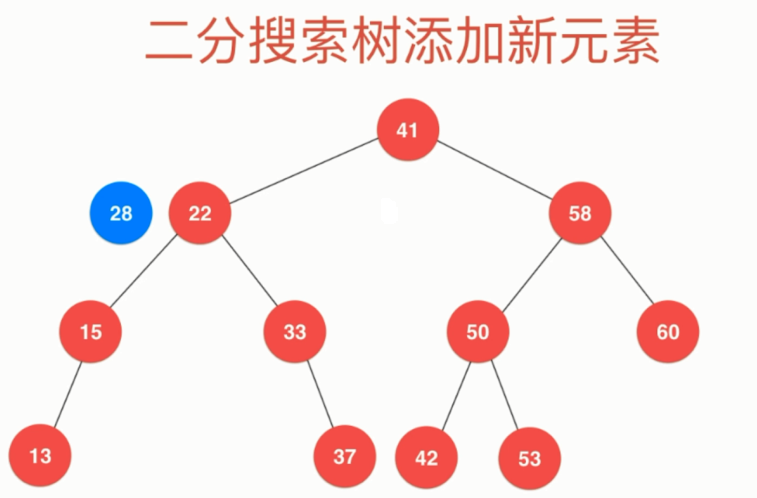
28 与左子树的根结点 22 比较,应该插入该结点的右子树
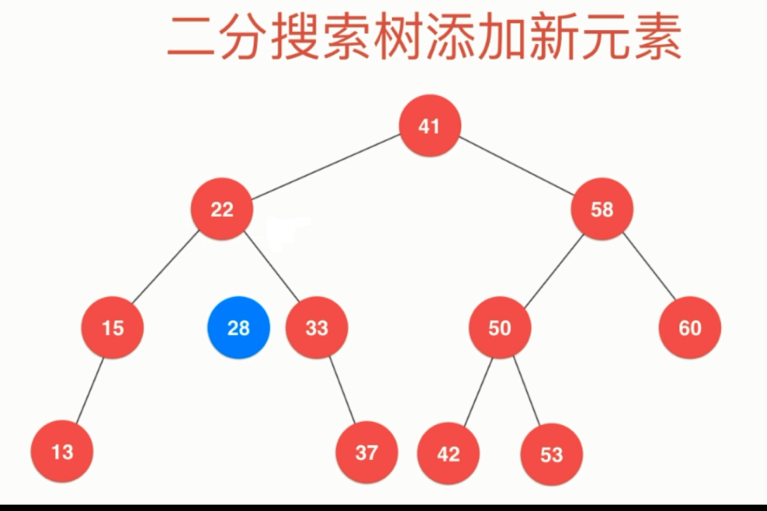
28 与 33 比较,应该插入该结点的左子树,该结点的左子树为空,则将值为 28 的结点添加到该结点的左子树中

最终将 28 添加到该 BST 中
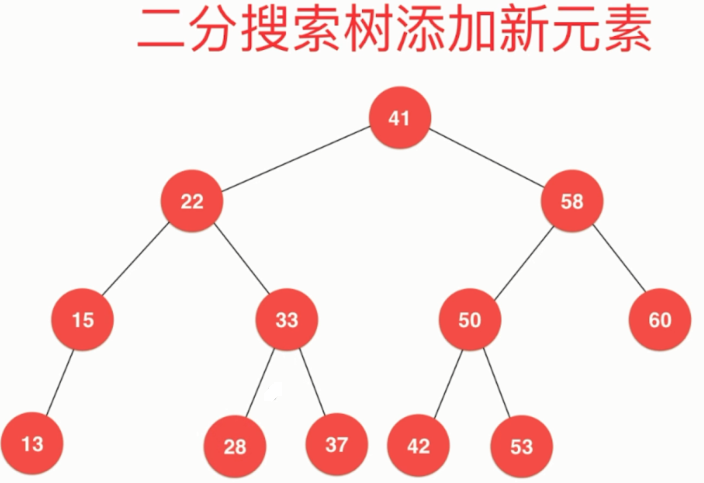
代码
//向BST中添加新元素e
public void add(E e){
if(root==null){
root=new Node(e);
size++;
return;
}else{
add(root,e);
}
}
//向以node为根节点的BST树种插入元素e
private void add(Node node,E e){
if(e.equals(node.e)){
//插入元素与根节点相等,直接返回
return;
}else if(e.compareTo(node.e)<0 && node.left==null){
node.left=new Node(e);
size++;
return;
}else if(e.compareTo(node.e)>0 && node.right==null){
node.right=new Node(e);
size++;
return;
}
if(e.compareTo(node.e)<0){
add(node.left,e);
}else{ //e.compareTo(node.e)>0
add(node.right,e);
}
}
改进添加元素
前文中的添加操作,对 root==null 的情况进行了特殊处理,并且 add(Node,E) 中的递归条件也太冗长了。
这里我们写一个 add() 方法,返回插入新节点后该 BST 的根节点
//向BST中添加新元素e
public void add(E e){
root=add(root,e);
}
//向以node为根节点的BST树种插入元素e
//返回插入新元素后该BST的根
private Node add(Node node,E e){
if(node==null){
size++;
return new Node(e);
}
//注意:对于e.equals(node.e)不做处理
if(e.compareTo(node.e)<0){
node.left=add(node.left,e);
}else if(e.compareTo(node.e)>0){
node.right=add(node.right,e);
}
return node;
}
查询元素
//查看BST中是否包含元素e
public boolean contains(E e){
return contains(root,e);
}
//查看以node为根节点的BST中是否包含元素e
private boolean contains(Node node,E e){
if(node==null){
return false;
}
if(e.compareTo(node.e)==0){
return true;
}else if(e.compareTo(node.e)<0){
return contains(node.left,e);
}else{
return contains(node.right,e);
}
}
遍历元素(递归形式)
前序遍历
//BST的前序遍历
public void preOrder(){
preOrder(root);
}
private void preOrder(Node node){
if(node==null){
return;
}
System.out.println(node.e);
preOrder(node.left);
preOrder(node.right);
}
/**
* 利用前序遍历打印 BST
*/
@Override
public String toString() {
StringBuilder res=new StringBuilder();
generateBST(root,0,res);
return res.toString();
}
//生成以node为根节点,深度为depth的描述二叉树的字符串(利用前序遍历)
private void generateBST(Node node,int depth,StringBuilder res){
if(node==null){
res.append(generateDepth(depth)+"null\n");
return;
}
res.append(generateDepth(depth)+node.e+"\n");
generateBST(node.left,depth+1,res);
generateBST(node.right,depth+1,res);
}
private String generateDepth(int depth){
StringBuilder res=new StringBuilder();
for(int i=0;i
res.append("--");
}
return res.toString();
}
中序遍历
//BST的中序遍历
public void inOrder(){
inOrder(root);
}
private void inOrder(Node node){
if(node==null){
return;
}
inOrder(node.left);
System.out.println(node.e);
inOrder(node.right);
}
后序遍历
//BST的后序遍历
public void postOrder(){
postOrder(root);
}
private void postOrder(Node node){
if(node==null){
return;
}
postOrder(node.left);
postOrder(node.right);
System.out.println(node.e);
}
遍历元素(非递归形式)
//枚举命令,GO表示访问元素,COUT表示打印元素
private enum Command{GO,COUT};
private class StackNode{
Command command;
Node node;
StackNode(Command command,Node node){
this.command=command;
this.node=node;
}
}
前序遍历
//BST的前序遍历(非递归方式)
public void preOrderNR(){
preOrderNR(root);
}
private void preOrderNR(Node node){
if(node==null){
return;
}
Stack stack=new Stack<>();
stack.push(new StackNode(Command.GO,node));
while(!stack.isEmpty()){
StackNode stackNode=stack.pop();
Node n=stackNode.node;
Command command=stackNode.command;
if(command==Command.COUT){
System.out.println(stackNode.node.e);
}else{
if(n.right!=null){
stack.push(new StackNode(Command.GO,n.right));
}
if(n.left!=null){
stack.push(new StackNode(Command.GO,n.left));
}
stack.push(new StackNode(Command.COUT,n));
}
}
}
中序遍历
//BST的中序遍历(非递归方式)
public void inOrderNR(){
inOrderNR(root);
}
private void inOrderNR(Node node){
if(node==null){
return;
}
Stack stack=new Stack<>();
stack.push(new StackNode(Command.GO,node));
while(!stack.isEmpty()){
StackNode stackNode=stack.pop();
Node n=stackNode.node;
Command command=stackNode.command;
if(command==Command.COUT){
System.out.println(stackNode.node.e);
}else{
if(n.right!=null){
stack.push(new StackNode(Command.GO,n.right));
}
stack.push(new StackNode(Command.COUT,n));
if(n.left!=null){
stack.push(new StackNode(Command.GO,n.left));
}
}
}
}
后序遍历
//BST的后序遍历(非递归方式)
public void postOrderNR(){
postOrderNR(root);
}
private void postOrderNR(Node node){
if(node==null){
return;
}
Stack stack=new Stack<>();
stack.push(new StackNode(Command.GO,node));
while(!stack.isEmpty()){
StackNode stackNode=stack.pop();
Node n=stackNode.node;
Command command=stackNode.command;
if(command==Command.COUT){
System.out.println(stackNode.node.e);
}else{
stack.push(new StackNode(Command.COUT,n));
if(n.right!=null){
stack.push(new StackNode(Command.GO,n.right));
}
if(n.left!=null){
stack.push(new StackNode(Command.GO,n.left));
}
}
}
}
层序遍历
//BST的层序遍历
public void levelOrder(){
Queue q=new LinkedList<>();
q.add(root);
while(!q.isEmpty()){
Node node=q.remove();
System.out.println(node.e);
if(node.left!=null){
q.add(node.left);
}
if(node.right!=null){
q.add(node.right);
}
}
}
删除元素
删除最小值和最大值
寻找 BST 中的最小元素和最大元素
//寻找BST中的最小元素
public E min(){
if(size==0){
throw new IllegalArgumentException("BST is emmpty");
}
return min(root).e;
}
private Node min(Node node){
if(node.left==null){
return node;
}
return min(node.left);
}
//寻找BST中的最大元素
public E max(){
if(size==0){
throw new IllegalArgumentException("BST is emmpty");
}
return max(root).e;
}
private Node max(Node node){
if(node.right==null){
return node;
}
return max(node.right);
}
删除BST中的最大值和最小值
情况一:最小值是叶子节点。直接删除该节点
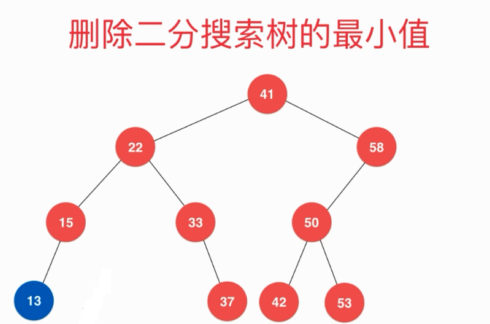

情况二:最小值有右子树。删除该节点,再将该节点的右子树连接到原来的 BST 中
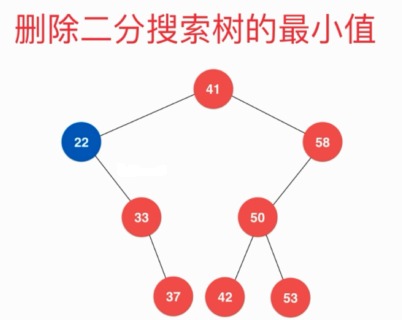
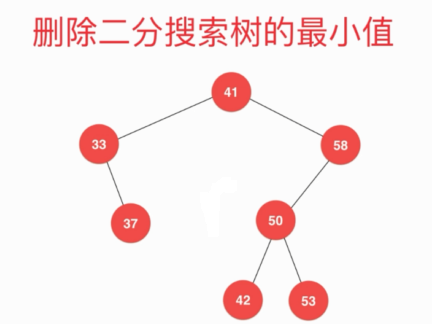
代码:
//删除BST中的最小值
public E delMin(){
E res=min();
delMin(root);
return res;
}
//删除以node为根结点的BST中的最小值元素
//这里考虑最小值只有右子树的情况,因为叶子节点是其特例
private Node delMin(Node node){
if(node.left==null){
Node nodeRight=node.right;
node.right=null;
size--;
return nodeRight;
}
node.left=delMin(node.left);
return node;
}
//删除BST中的最大值
public E delMax(){
E res=max();
delMax(root);
return res;
}
//删除以node为根结点的BST中的最大值元素
private Node delMax(Node node){
if(node.right==null){
Node nodeLeft=node.left;
node.left=null;
size--;
return nodeLeft;
}
node.right=delMax(node.right);
return node;
}
删除任意元素
删除只有左孩子的节点。直接删除即可
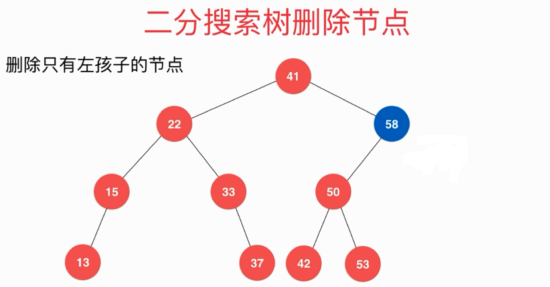
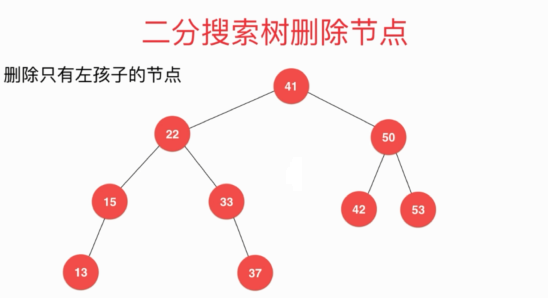
删除只有右孩子的节点。直接删除即可

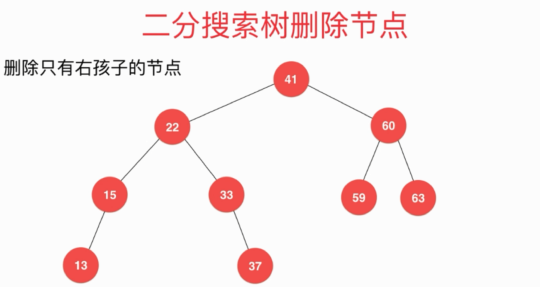
删除左右孩子都有的节点

Habbard-Deletion:
d 是待删除的节点,s 节点是 d 的后继,也就是 d 的右子树的最小值所在的节点。
注意:这里选择左子树的最大值所在的节点效果也是相同的。
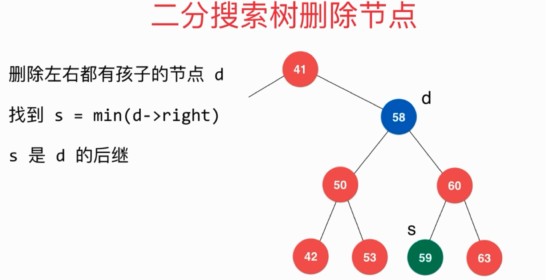
使用 s 代替 d
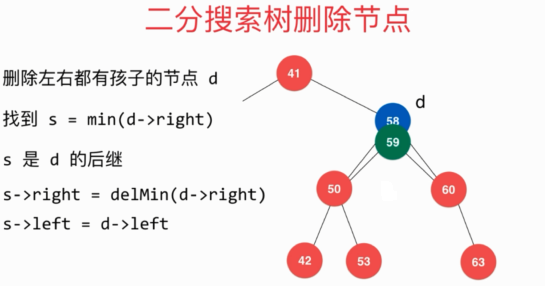
最后删除 d 节点
代码
//删除BST中任意元素
public void del(E e){
root=del(root,e);
}
private Node del(Node node,E e){
if(node==null){
return null;
}
if(e.compareTo(node.e)<0){
node.left=del(node.left,e);
return node;
}else if(e.compareTo(node.e)>0){
node.right=del(node.right,e);
return node;
}else{
//节点node就是要删除的节点
//该节点只右有子树
if(node.left==null){
Node rightNode=node.right;
node.right=null;
size--;
return rightNode;
}
//该节点只有左子树
if(node.right==null){
Node leftNode=node.left;
node.left=null;
size--;
return leftNode;
}
//删除既有左子树又有右子树的节点
Node s=min(node.right);
s.right=delMin(node.right);
s.left=node.left;
//删除node
node.left=node.right=null;
return s;
}
}
哈夫曼树
哈夫曼树的构造过程
首先生成一颗哈夫曼树,每次生成过程中选取频率最少的两个节点,生成一个新节点作为它们的父节点,并且新节点的频率为两个节点的和。选取频率最少的原因是,生成过程使得先选取的节点位于树的更低层,那么需要的编码长度更长,频率更少可以使得总编码长度更少。
生成编码时,从根节点出发,向左遍历则添加二进制位 0,向右则添加二进制位 1,直到遍历到叶子节点,叶子节点代表的字符的编码就是这个路径编码。
举例:
给定了四个结点a,b,c,d,权值分别为7,5,2,4。

找出现有权值中最小的两个,2 和 4 ,相应的结点 c 和 d 构建一个新的二叉树,树根的权值为 2 + 4 = 6,同时将原有权值中的 2 和 4 删掉,将新的权值 6 加入。
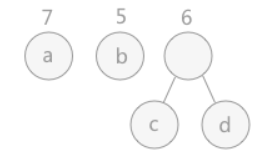
重复之前的步骤。
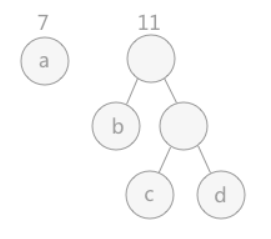
所有的结点构建成了一个全新的二叉树,这就是哈夫曼树。
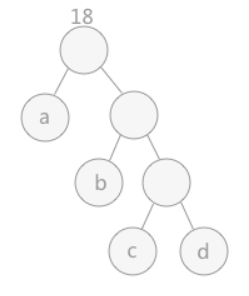
代码
public class Huffman {
private class Node implements Comparable {
char ch;
int freq;
boolean isLeaf;
Node left, right;
public Node(char ch, int freq) {
this.ch = ch;
this.freq = freq;
isLeaf = true;
}
public Node(Node left, Node right, int freq) {
this.left = left;
this.right = right;
this.freq = freq;
isLeaf = false;
}
@Override
public int compareTo(Node o) {
return this.freq - o.freq;
}
}
public Map encode(Map frequencyForChar) {
PriorityQueue priorityQueue = new PriorityQueue<>();
for (Character c : frequencyForChar.keySet()) {
priorityQueue.add(new Node(c, frequencyForChar.get(c)));
}
while (priorityQueue.size() != 1) {
Node node1 = priorityQueue.poll();
Node node2 = priorityQueue.poll();
priorityQueue.add(new Node(node1, node2, node1.freq + node2.freq));
}
return encode(priorityQueue.poll());
}
private Map encode(Node root) {
Map encodingForChar = new HashMap<>();
encode(root, "", encodingForChar);
return encodingForChar;
}
private void encode(Node node, String encoding, Map encodingForChar) {
if (node.isLeaf) {
encodingForChar.put(node.ch, encoding);
return;
}
encode(node.left, encoding + '0', encodingForChar);
encode(node.right, encoding + '1', encodingForChar);
}
}


)








\@Aspect练习)
_Java.util.Properties.store())



和自定义注解的使用)


